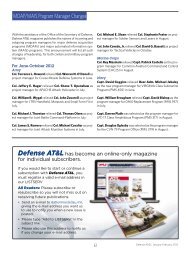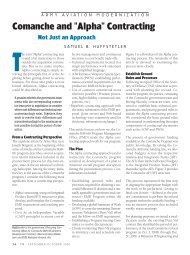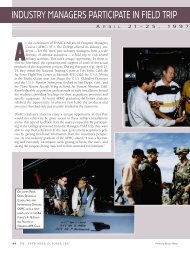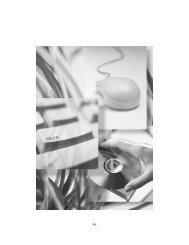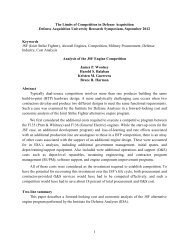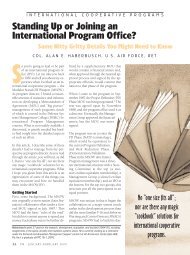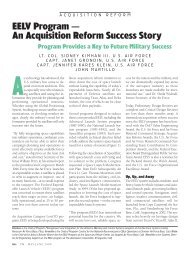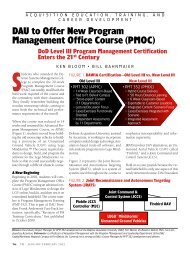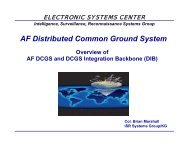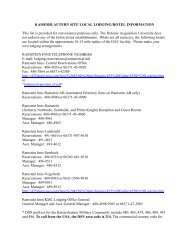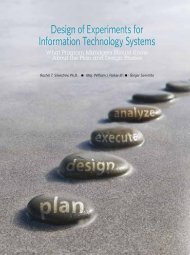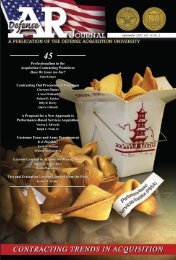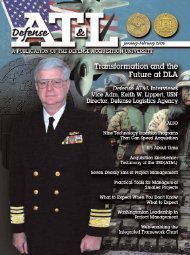Defense ARJ - Defense Acquisition University
Defense ARJ - Defense Acquisition University
Defense ARJ - Defense Acquisition University
You also want an ePaper? Increase the reach of your titles
YUMPU automatically turns print PDFs into web optimized ePapers that Google loves.
<strong>Defense</strong> <strong>Acquisition</strong> Review Journal<br />
defense are relatively stable and will generally be the same problems defined now as<br />
when they are eventually “solved” five or more years from now.<br />
Other assumptions presuppose that there is no better way to control spending<br />
from the perspective of those appointed as publicly responsible and accountable at the<br />
top of the governmental hierarchy; that the President and Congress unconditionally<br />
expect the DoD to propose the most efficient single course of action for spending; and<br />
that the PPBE approach is the most influential way to obtain and use resources in our<br />
system of government. These assumptions are as ingrained into the fabric of the DoD<br />
culture as to be considered by its members to be tacit knowledge (Polyani, 1966).<br />
From the postpositivist perspective, at least three issues with these beliefs are set<br />
forth in the PPBE paradigm:<br />
� PPBE creates myopic learning. Plans, programs, and budgets spawn specified<br />
expectations; hence, blind managers who overly focus on confirming predictions<br />
rather than preoccupying themselves and their organizations with updating<br />
their thinking especially in light of an uncertain environment.<br />
�<br />
�<br />
154<br />
PPBE undercuts organizational creativity and improvisation. Although plans,<br />
programs, and budgets seem to provide some contingent actions (i.e., plans<br />
for branches and sequels) based on present views of required capability,<br />
managers shun forms of adhocracy to deal with the unexpected; whereas,<br />
adhocracy may serve them and their clients better in some cases than institutionalized<br />
solutions.<br />
PPBE fosters “mindless” decision traps. Regulatory approaches to budgeting<br />
activities make even the smartest managers prone to repeat patterns of action<br />
that have worked in the past (a form of mindlessness); rather, being mindful of<br />
the uniqueness of situations that makes the pursuit of best practices or benchmarks<br />
seem dangerous.<br />
In contrast to the mental confines of strategic planning, continuous sensemaking<br />
demands being mindful, and both appreciating that something needs to be done<br />
and changing what to do. It demands the recognition that ends, ways, and means are<br />
transitory and will morph over time as political interpretations and environmental<br />
conditions change. It acknowledges that this process is interactive—the environment<br />
is affected by what is done and that the environment will reciprocate—in a never ending<br />
dynamic of interactive, mutually causal variables (Weick & Sutcliffe, 2001).<br />
senseMakinG WitH Political MinDfulness<br />
The paradigm associated with political reasoning is often difficult to discern from<br />
presumed technically rational approaches (such as PPBE) because the process is<br />
often intentionally or perhaps subconsciously masked by the appearance of unequivocal<br />
results of analyses. With political reasoning, however, there can be no set linear<br />
programming steps; albeit, politicians, political appointees, and their constituents<br />
may believe or give the appearance that they are one and the same (Stone, 1999). The<br />
nature of political reasoning may include distinctive qualities such as: use of equivo-



